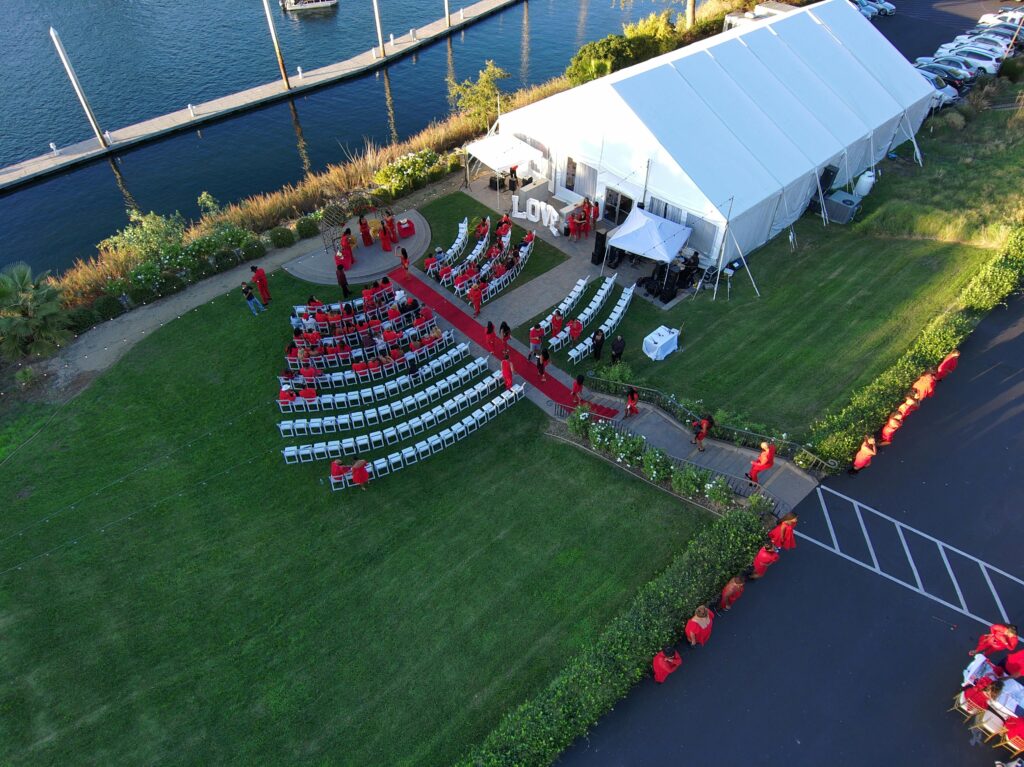How to Know the Right Tent Size for Your Occasion

Planning an event involves many moving parts, and one of the most important decisions is choosing the right tent size. A tent serves as the foundation of your event space. It offers guests a comfortable shelter, provides the right ambiance, and is functional too. Pick one that’s too small, and your guests will feel cramped. Choose one that’s too large, and the space may feel empty and underwhelming.
So, how do you determine the perfect tent size? Factors like guest count, seating arrangements, and event type all come into play.
Whether you’re wondering what tent size will fit 100 guests or how big of a tent you should get for 200 guests, this guide will break down everything you need to know.
Understanding Tent Sizes and Their Importance
When choosing a tent, it’s important to understand how tent sizes are measured. Tents come in different dimensions, typically listed in feet (e.g., 20×40, 30×60).
The first number represents the width, while the second represents the length. Together, these measurements determine the total square footage, which directly impacts how many guests can fit comfortably.
Different types of tents also affect how much usable space you get:
- Pole Tents – These require center poles for support, which can slightly reduce available space inside. They work well for grassy areas and large outdoor events.
- Frame Tents – These don’t have center poles, making them more flexible for seating arrangements. They’re a great choice for weddings and corporate gatherings.
- Clear-Top Tents – These feature a transparent roof, adding elegance to evening events. They work well when you want an open, airy feel.
For example, a 20×40 tent capacity might be enough for a small wedding reception, but if you add a dance floor and buffet tables, you may need a larger option.
The key is knowing how different tent styles and layouts affect space so you can choose wisely.
What Tent Size is Suitable for 100 Guests?
One of the most common questions when planning an event is: What tent size can comfortably accommodate 100 guests? The answer depends on your seating arrangement and event style.
Here’s a general guideline based on different layouts:
- Banquet-style seating (round tables) – Requires around 1,200-1,500 square feet. This setup is common for weddings and formal dinners, where guests are seated at round tables.
- Theater-style seating (rows of chairs) – Needs about 1,000-1,200 square feet. This is ideal for ceremonies, speeches, or corporate presentations.
- Cocktail-style setup (standing with scattered tables) – Around 800-1,000 square feet. Great for networking events or casual receptions with high-top tables.
For example, if you’re hosting a sit-down dinner, a 20×40 tent capacity (800 square feet) won’t be enough for 100 guests. You’d need a tent closer to 30×40 or 40×40 to ensure everyone has enough room. If your event includes a dance floor, buffet, or stage, you may need even more space.
Before finalizing your tent, consider how your guests will be seated and whether additional features—like a bar or lounge area—will require extra room.
How Big of a Tent Do I Need to Accommodate 200 Guests?
If you’re expecting 200 guests, your tent needs to provide enough space for comfort and functionality. The required size depends on the seating arrangement and any additional elements you plan to include.
Here’s a breakdown of how big of a tent you need for 200 guests based on different layouts:
- Banquet-style seating (round tables) – Requires 2,400-3,000 square feet to allow guests to move comfortably while seated at round tables.
- Theater-style seating (rows of chairs) – Needs approximately 2,000-2,400 square feet, ideal for ceremonies, presentations, or speaking engagements.
- Cocktail-style setup (standing with scattered tables) – Around 1,600-2,000 square feet is sufficient for mingling and light seating.
For example, a 20×40 tent capacity (800 square feet) is far too small for 200 guests, even with a cocktail-style setup. Instead, you’d need a 40×60 or 50×60 tent to comfortably accommodate banquet seating. Take note that you may need an even bigger space to accommodate a stage, dance floor, buffet tables, or other features.
To ensure the right fit, always consider the full scope of your event—not just the guest count but also any extra elements that take up floor space.
Tent Sizes for Events: Key Factors to Consider
Choosing the right tent sizes for events goes beyond just counting guests. Several factors influence how much space you’ll need to ensure your event runs smoothly. These include:
1. Type of Event
The nature of your event plays a big role in tent sizing. A formal wedding with round tables, a dance floor, and a buffet requires more space than a networking event with cocktail tables. A corporate seminar with theater seating needs different spacing than a family reunion with picnic-style seating.
2. Additional Space Requirements
It’s easy to focus on seating alone, but don’t forget other space-consuming elements:
- Dance floor – Requires 200-400 square feet, depending on how many people will be dancing.
- Buffet tables & catering stations – Typically need 100-200 square feet.
- Bars & drink stations – Can take up 100-150 square feet, depending on the setup.
- Stage or entertainment area – Needs at least 200-400 square feet.
3. Venue & Layout Considerations
The available space at your venue can impact which tent sizes work best. If you’re setting up on grass, a pole tent may be an option. If you’re on pavement, a frame tent might be more suitable. Also, consider whether the location has trees, slopes, or other obstacles that could limit tent placement.
4. Weather Conditions & Comfort
If your event is outdoors, weather plays a role in tent selection. Hot, humid conditions may require sidewall ventilation and extra space for airflow. Rainy or windy conditions might mean choosing a sturdier frame tent with sidewalls to keep guests comfortable.
5. Guest Movement & Walkways
Even with the perfect seating arrangement, your event needs clear pathways for guests to move around comfortably. Consider space for:
- Aisles between tables (at least 3-5 feet wide).
- Entry and exit points (especially important for larger gatherings).
- Walkways to food stations, bars, restrooms, or entertainment areas.
A common mistake is packing tables too closely together, leaving guests struggling to move around. Proper spacing keeps your event feeling open and welcoming.
6. Type of Flooring
While many tents are set up directly on grass, some events may require flooring. Installing a dance floor or a solid floor for high heels and formal attire will take up extra space. Raised flooring also affects tent height, which could impact your tent selection.
7. Lighting & Décor Requirements
If you’re planning an evening event, lighting fixtures like chandeliers, string lights, or uplighting might require additional height clearance. Some décor elements, such as large floral installations or hanging drapes, may also impact the amount of usable space inside the tent.
8. Type of Seating & Table Shapes
The style of seating and table shapes affect space efficiency.
- Round tables take up more space but feel more intimate.
- Rectangular tables are more space-efficient and work well for long banquet-style arrangements.
- Lounge seating (sofas, cocktail tables) can require extra space compared to traditional seating.
Final Tip: Don’t Base Your Decision on How Much Tents Are
Budget is always a factor when planning an event, but choosing a tent size based only on cost can lead to major issues on the day of your event. While it might be tempting to go with the cheapest option, a tent that is too small or lacks the necessary features can create unnecessary stress and discomfort for your guests.
Some budget-friendly tent options don’t include sidewalls, flooring, or sturdy framing, which can be a problem depending on your venue and weather conditions. If your event takes place during a windy or rainy season, a tent with proper reinforcements is necessary. Skimping on these features could mean dealing with water leaks, unstable structures, or poor airflow.
What’s more, choosing a tent that doesn’t fully meet your needs might lead to additional expenses. If the tent is too small, you may need last-minute add-ons like an additional smaller tent or side extensions. If the tent lacks flooring and it rains, you might have to rent flooring unexpectedly.
These extra costs can make the “cheaper” option more expensive than renting the right size from the start. So, if you want a stress-free event, make sure to choose the right tent size that won’t compromise the overall occasion.
Get The Right Tent Size for Your Upcoming Event
Choosing the right tent size is one of the most important decisions when planning an event. It ensures your guests have enough space to move comfortably while allowing room for tables, walkways, and any extras like a dance floor or catering stations. Whether you’re figuring out what tent size is good for 100 guests or how big of a tent should you get for 200 guests, taking all event details into account will help you avoid costly mistakes.
At Houston Party Rental, we help event planners, businesses, and individuals find the perfect tent for their needs. Our team can guide you through tent sizes, setup options, and additional features to ensure your event’s success.
Contact us today to learn more about our rental services and get the best tent for your occasion.




